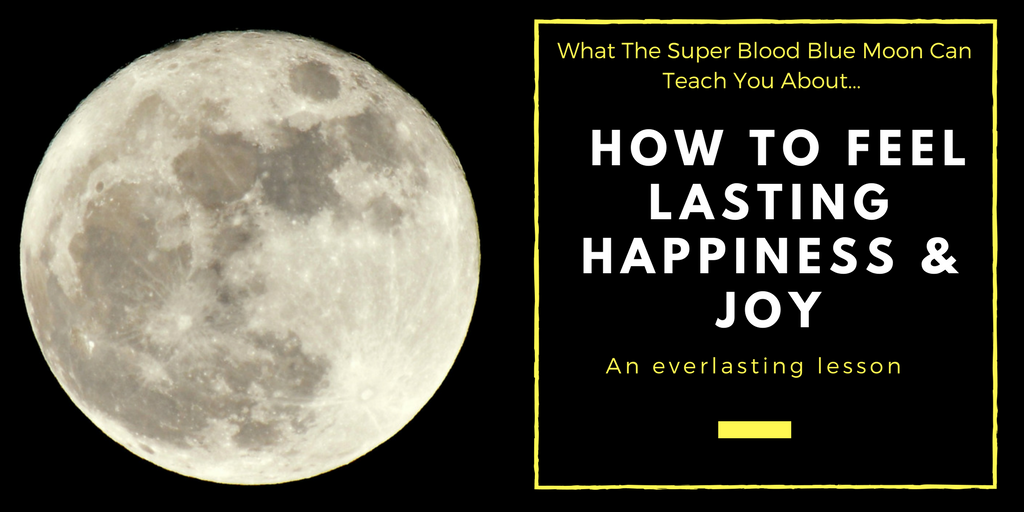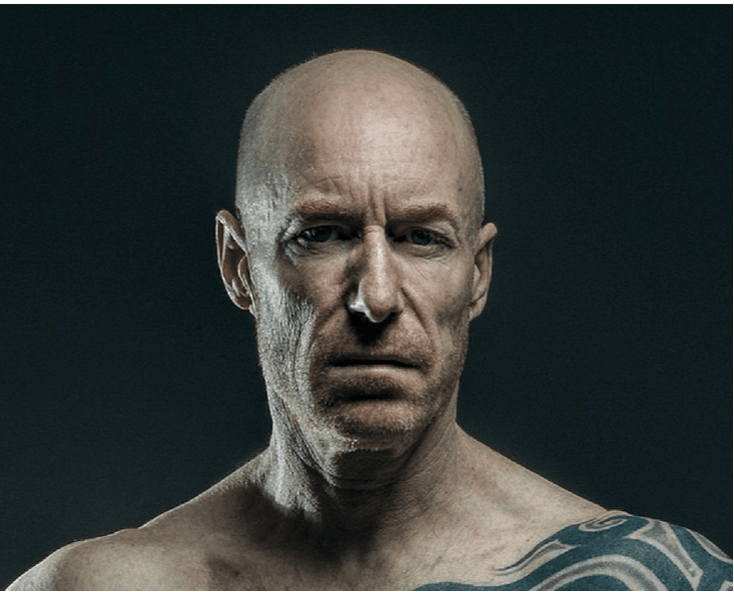|
You’ve probably heard already about…
The super blue blood moon. It’s a combination of three things:
Do you think all the weird things that happen on a full-moon will be amplified? Such as:
Either way… Here’s a hefty lesson to pull out today: Life has these big events. Big celebrations. Big Milestones. On these days, people are conditioned to allow themselves to celebrate or “be happy”. But when it comes to the small steps… the mini-milestones… the little joys… Most people “poo-poo” on those. They don’t think they are significant enough to celebrate. They don’t allow themselves to extract the happiness from those. Instead, they wait for the BIG achievements. And thus, they miss the magic from the little moments. Use this rare day as a reminder to find the magic in everyday moments… everyday progress… even if you’re not at your goal yet. Remember to celebrate and cheer yourself on with each step forward. And you’ll find the more you do this, the more you’ll find them.
0 Comments
Have you seen IT?
(The remake or the original) If so, you know in one fell-swoop this movie ruined clowns for generations. People are terrified of clowns and Stephen King (the author of the book) is partially to blame for that. If you haven’t seen the movie… --Minor spoiler alert-- Here’s the gist of it: In a small town in Maine, there’s a menace lurking in the sewers. A monster disguised as a creepy clown (called IT) who hunts down little kids. However, IT also turns into your worst fear. Whether that’s clowns… werewolves… dogs… lepers… mummies… (I don’t know anyone who was afraid of those though) In the story, the main characters discover IT’s main power is fear. When kids fear him, he has immense leverage over them. But if the kids aren’t afraid, he loses a ton of his power – plus they can physically fight back. This is such a great metaphor for real-life. Let me explain: When we are afraid of something (whether it’s logical or not) how often do we make it bigger than it is? Or way worse than it really is? Our mind is so creative, that we can conjure up absolutely terrifying scenarios. And often, when we finally confront that fear, it’s like, “Wow this wasn’t bad at all” Like an overinflated balloon, our mind blew it up way bigger than what it really was. You see, fear only has power over us when we run from it, when we don’t face it. But once we face it, like disconnected battery it no longer has power. So how do we face fear? The simplest way is to… Just do it. Problem is, biologically our brain goes hay-hire during stress and anxiety. And it can be a herculean task to overpower that built-in response. Instead, there are psychological-tactics that can override this natural biological response. The dust has finally settled.
And the holiday stampede is trailing off in the distance. It can bring love, joy, gratitude and deep connection with family… but also shockwaves of stress and anxiety along with it. Here are two common patterns of anxiety and stress that run rampant for the Holidays. (But if you read carefully, you’ll notice these two ring-true all year long)
Plus, unlike other times of the year, it’s harder to escape these commitments.
There’s staggering pressure for making it the best experience, purchasing the best gifts, preparing the best meals – all the while holding it together for loved ones. And while this love for others is admirable it leaves a trail of exhaustion, overwhelm and stress in its wake. So what’s the holiday goer to do? Just about everyone I’ve met who struggles with holiday stress gets caught up in a vicious cycle of taking care of everyone else… but themselves. And this happens at times year round too, doesn’t it? If I can hand you one shiny gift this holiday season it’s this: I challenge you to reignite your focus on taking care of yourself. You deserve it. You’ll enjoy it. You’ll be more productive. You’ll be happier. You’ll be less stressed. You’ll be stronger. You’ll serve others better. Some people believe: If they take care of themselves, it’ll take away from others. Quite the contrary… The more you take care of yourself, the more you can take care of others. In fact, researchers Van Yperen, Buunk, and Schaufeli, published a study in the Journal of Applied Psychology on this connection. They found that health care professionals that were more immune to burnout were those who helped others but also sought out help and support when they needed it. It’s like that safety lecture on a plane. In an emergency when those yellow rubber masks flop down from the ceiling, the instructions are: “Please secure your own mask before those around you” Same thing here: If you want to help others, we have to help ourselves. If you want others to be at their best, we have at to be at our best. And there are lots of ways to make that happen. Here’s a jump-start though: What activities energize you? What hobbies or activities allow you to be at your best? What activities really make you happy? What activities used to bring joy to your life? And then get the ball rolling on those again. We’ve all had bad days.
Or at least we think they’re bad until… we hear about REAL BAD DAYS. Dan Sullivan is the founder of Strategic Coach. He’s in charge of one of the most elite programs for entrepreneurs. Early in his career he faced what he describes as the worst day of his life. On this fateful day, his business went bankrupt. AND his wife divorced him! Think about that. One of these would be enough to immobilize someone. Let alone both! How does someone bounce back from that? At first, he did the natural thing and began blaming people and circumstances for why it all happened. But then something interesting happened… He snapped himself out of it. He stopped and made two life-changing decisions:
Can you imagine that? Being able to relieve everyone of responsibility in a situation like that? He did it all so he could get his power back. Someone else who has taken this lesson is Gerry Spence. He is a lawyer who has NEVER lost a single criminal case. He describes a common situation that we’ve all encountered. Have you ever faced some situation or some person and it just seemed so daunting? It’s like our imagination made this thing so much larger or so much more intimidating than it really was. Spence had this happen as he was up all night preparing for a case. He was up against a defense attorney for an insurance company who he made out to be the perfect person. He imagined him as having a perfect life, perfect house, perfect family, and having perfect communication. The truth was he was disempowering himself. He was using his power against himself. He was making this person so big that he wasn’t able to perform at his best. This was massive lesson Spence learned. He states, “If I have endowed the other person with power that the other person does not possess, then I face my own power. My own power has become my opponent, my enemy. I have long since refused to relinquish any of my power to my opponent. I keep my power. I use it to prepare my case, to care about my case, to care for my client”- Gerry Spence This is something I remind myself of and my clients of. It’s about taking charge and using the power that we all have inside and not to give it up. If you have temporarily lost your power, it’s time to get it back. The strength you need – is the strength within. One day I was waltzing around on Facebook
(No I was not looking at funny cat videos) I noticed a client shared a video with me that ended up being VERY profound. In fact, I watched it a couple times to really grasp the message. It was a video from Dr. Abraham Twerski on how lobsters deal with stress. You may be wondering, why do I need to know how lobsters deal with stress? At first, that’s what I thought too. Most people know, lobsters are a soft (and delicious) animal but they live inside a rigid and hard shell. However, the shell does NOT expand. Over time, the lobster grows and begins to feel under pressure… uncomfortable… and limited… in this shell. To deal with this pain it hides underneath rocks, breaks out of its shell, and grows a new one. But you know what happens? This shell also eventually gets too small and uncomfortable so it repeats the process. And it repeats this process over and OVER. The stimulus for the lobster to grow is the discomfort - the pain. Pain is the sign that we are hitting our limits. It’s like doing pushups. At first maybe we can only do a couple but as our strength increases our capacity to do more increases. It is the necessary resistance to grow. Use it to go to the next level. How to Deal With Negativity, Negative Thoughts and Self-DoubtJames Lawrence is a beast.
He has NOT just completed an iron-man… This is one of the most brutal and challenging races in the world where competitors do a 2.4-mile swim… 112-mile bike ride… and 26.2-mile run. To finish one is a major accomplishment… he’s shattered the world-record by completing 30 in one year. I loved this quote by him: The hardest thing has probably been not listen to the people that say you can’t do it, to turn down the volume on all the negativity, and to focus on the things that are positive, the things that are up-lifting, and the things that drive you forward to the finish line. Sure, most of us may not want to do even one Iron-man (let alone 30!). But there is wisdom here. Often, we put certain people up on a pedestal and think “They are so successful; they don’t have the same struggles that I do. They don’t struggle with negative thoughts… people who aren’t supportive… and the doubt that I do…” We may not see those struggles but they are there. As author Stephen Covey said, The private victory precedes the public victory Truth is, even they struggle with this. Everyone faces these challenges – the question is what to do about them. |
Restore Your Confidence & StrengthArchives
April 2019
|




 RSS Feed
RSS Feed